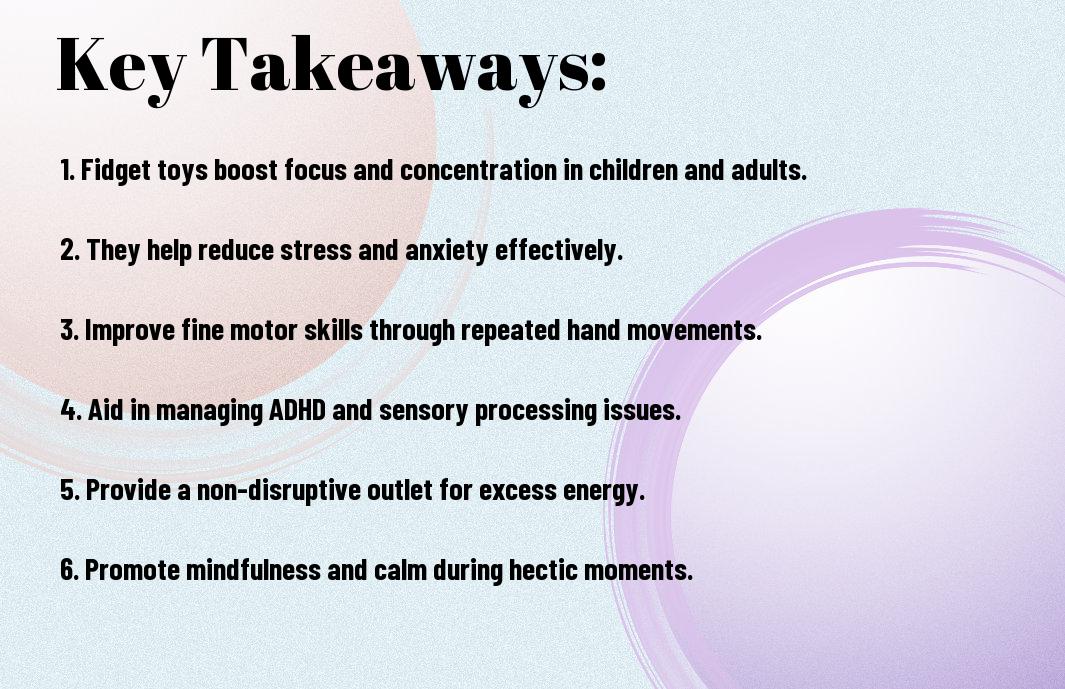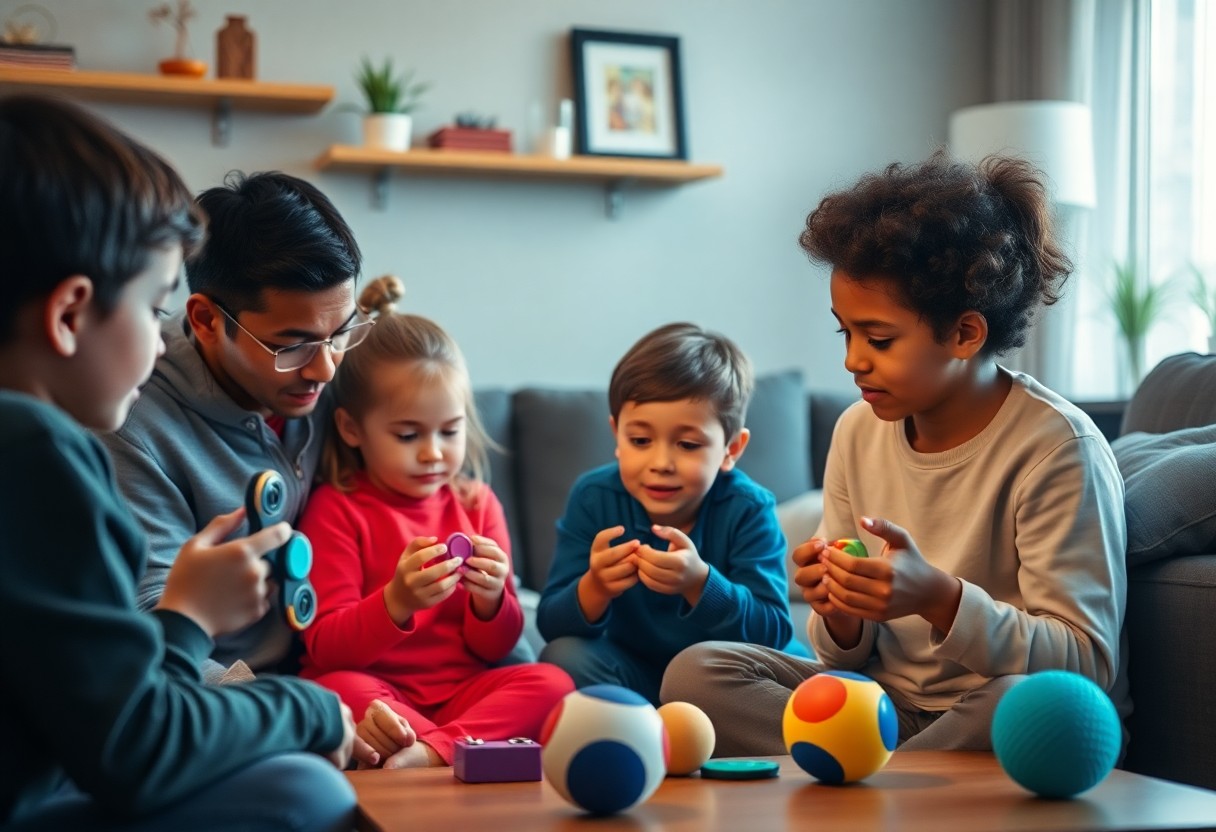Just when you thought fidget toys were fading away, they’ve proven to be a lasting tool for enhancing focus and managing stress. These engaging gadgets offer multiple benefits for both kids and adults, helping you channel nervous energy and improve concentration. If you’ve ever felt overwhelmed by distractions, incorporating fidget toys into your daily routine can lead to positive changes in your mental well-being. Dive into this article to discover five key benefits that might just transform how you think about these popular objects. For a deeper understanding, check out Fidget Toys: What Are They and How Can They Help ….
Key Takeaways:
- Fidget toys serve as effective tools for stress relief and anxiety reduction, benefiting both children and adults by providing a physical outlet for nervous energy.
- They enhance focus and concentration by allowing users to engage their hands while attending to tasks, making them particularly useful for those with ADHD or similar conditions.
- Fidget toys can improve fine motor skills and hand-eye coordination, offering a playful way to develop these vital abilities in kids and adults alike.

The Neurological Benefits of Fidgeting
The Mechanics of Focus and Attention
Your brain is constantly processing information, and distractions can easily pull your attention away from tasks. Fidgeting has a surprising ability to help maintain that focus. By engaging in physical movement, you create a channel for the brain to filter out unnecessary distractions. Rather than simply being a source of annoyance or distraction, these small, repetitive movements act as a sensory stimulus that can help anchor your thoughts back to the task at hand. Studies indicate that when you enable your body to fidget, you allow your mind to remain engaged, leveraging the dual-action of fidgeting to keep boredom at bay while also honing in on mental tasks.
A 2000 study published in the journal “Journals of Gerontology” showed that people who fidgeted while engaging in cognitive tasks performed better than those who sat still. The act of fidgeting generates an undercurrent of sensory activity that assists your brain in staying attuned to your environment. The more you tap, squeeze, or spin your fidget tool, the more your brain is encouraged to concentrate on complex problems without succumbing to outside distractions. In essence, your brain thrives on stimulation, and fidgeting offers a manageable outlet that enriches your focus.
These mechanics of focus can be particularly beneficial for children and adults diagnosed with attention deficits. By allowing movement through fidget toys, many learners report enhanced attention span and an increased ability to absorb information. Consequently, whether it’s in a classroom setting or during a long meeting, providing a fidgeting outlet allows you to gain the benefits of active participation while still respecting the need for movement.
How Fidget Toys Stimulate Brain Activity
Fidget toys operate by stimulating multiple areas of the brain through repetitive motion and tactile interaction. As you manipulate these toys, numerous neural pathways become engaged, which fosters heightened reaction times and overall cognitive functionality. Fidget toys provide a rich sensory experience that is often missing in our everyday environments, thus leading to increased levels of dopamine—an vital neurotransmitter associated with pleasure and attention. This chemical boost can lead to a more motivated mindset, improving your enthusiasm for tasks and keeping those brain gears turning.
Engaged in repetitive movements, you’ll find that your creative side may flourish while using fidget toys. An enhanced state of “flow” occurs as the rhythmic motions generate a sense of calm. A 2018 study from the University of California found that participants shown to use fidget tools during creative tasks scored significantly higher on measures of innovation compared to those working in standard conditions. This demonstrates how these toys don’t merely serve to distract but actively enhance cognitive processing by providing a low-level stimulation that supports creativity.
Further exploring the stimulation of brain activity through fidget toys reveals their role in enhancing both fine and gross motor skills, which can be particularly beneficial for children developing coordination. By manipulating different textures, shapes, and weights, your brain learns to adapt to ever-changing stimuli, reinforcing spatial awareness and dexterity. Ultimately, the stimulation from fidgeting can serve as a refined approach to cognitive enhancement through engaging both your mind and body concurrently.
Emotional Regulation: A Tool for Anxiety Management
Fidgeting as a Coping Mechanism
Fidgeting serves as an instinctive response to anxiety, often providing an outlet for unease or restlessness. Many individuals, whether children or adults, find themselves tapping their feet, twirling pens, or squeezing stress balls when faced with stressful situations. This seemingly simple behavior has profound psychological advantages, as it allows your body to dissipate nervous energy. Research has shown that fidgeting can act as a form of self-soothing, enabling you to regain focus and calmness in intense environments such as classrooms or workplaces. For example, a student battling school anxiety may use a fidget spinner during lessons to help maintain concentration, ultimately leading to improved academic performance.
Utilizing fidget toys can offer you a productive way to channel your anxiety rather than succumbing to it. In high-pressure scenarios, curling your fingers around a specialized fidget toy can create a sense of normalcy amid chaos, providing a welcomed distraction. A study that examined the effects of fidget toys depicted a significant reduction in reported feelings of apprehension. When you fidget, your brain becomes engaged in the repetitive actions, which lowers stress levels and directs your thoughts away from anxiety-inducing stimuli.
As a broader coping mechanism, this fidgeting behavior demonstrates how you can adaptively manage your emotional landscape. Having access to specific fidget tools allows for personalized approaches to anxiety, catering to your unique needs. Whether you prefer a simple stress ball or a more complex fidget cube, these toys serve as tangible solutions to emotional upheaval, helping you develop a sense of agency over your anxiety. This isn’t merely a trendy practice; it’s a practical application of behavioral science at your fingertips.
The Role of Sensory Input in Anxiety Reduction
Sensory input plays a pivotal role in the process of alleviating anxiety. When you interact with fidget toys, your sense of touch is activated, creating sensory feedback that can ground you in the moment. For instance, the texture of a textured fidget toy can provide comfort, while the act of manipulating it diverts attention from your racing thoughts. Engaging your senses helps to stimulate the brain’s reward system, releasing dopamine, a neurotransmitter associated with feelings of pleasure and satisfaction. This response can lead to a decrease in anxiety levels almost instantaneously, aiding in emotional stabilization.
Fidget toys often incorporate varying textures, sounds, and movements, which contribute substantially to emotional wellness. For instance, the soft clicks of a fidget cube can provide auditory feedback that adds to the sensory experience, enhancing your ability to focus and relax. Various materials and designs cater to different sensory preferences, allowing you to discover what works best for you. Studies indicate that sensory-rich fidget tools can significantly impact emotional self-regulation, helping to reduce signs of distress or tension during overwhelming moments.
Exploring several types of sensory input through fidget toys encourages you to find what aligns best with your coping strategies. Whether it’s the smooth motion of a spinner or the satisfying squish of a stress ball, the options abound when crafting your personal toolkit for anxiety management. These choices enable you to become more attuned to your emotional needs, integrating sensory experiences that promote calmness in your daily life. In this way, fidget toys are not just accessories; they are vital components of a comprehensive approach to mental wellbeing.

Enhancing Motor Skills and Coordination
Fine Motor Development in Children
Using fidget toys can significantly boost fine motor skills in children, a critical aspect of their overall development. Engaging with small, tactile objects enhances your child’s ability to manipulate items with precision, which is vital for tasks such as writing, buttoning clothes, or using utensils. For instance, products like fidget spinners, squeeze balls, or sensory putty require varied hand movements that build hand strength and coordination. Children who regularly engage in these activities can often perform daily tasks more easily and with greater confidence.
The repetitive motions involved in using fidget toys promote muscle memory. You may notice that your child becomes more adept at making small, intricate movements over time, such as pinching, rolling, and twisting. These activities stimulate the brain’s neural pathways involved in coordination, helping to foster not just fine motor skills but also concentration and focus. Providing access to these tools in an educational environment can create a well-rounded approach to learning, enabling children to better engage with their studies.
Additionally, fidget toys offer a unique connection to creative and problem-solving skills. As children experiment with various fidgeting methods, they often develop their own play styles and techniques, allowing them to explore their creativity while honing their motor functions. As your child plays and interacts with these toys, they are not only having fun but are also laying a foundation for skills they will use throughout their lives.
Practical Benefits for Adults in the Workplace
For adults, the workplace can often be a source of stress and distraction. Utilizing fidget toys can offer practical benefits by enhancing not only motor skills but also productivity and mental clarity. Engaging in brief, rhythmic movements with a fidget tool can recharge your focus, enabling you to manage a busy and demanding work environment more efficiently. Whether you’re tapping a fidget cube or spinning a desk toy, the act itself can help transition your mind back to the task at hand, reducing procrastination and promoting sustained attention.
The integration of fidget toys into office routines can also lead to improved hand-eye coordination, especially during repetitive tasks such as typing or data entry. As you manipulate your fidget toy, you’re subtly enhancing your coordination without even realizing it. This direct link between fine motor activity and improved task performance exemplifies how fidget tools can transform the way you interact with your work. Additionally, studies have shown that engaging the body in physical movement can stimulate cognitive processes, allowing you to think more creatively and solve challenges effectively.
These benefits extend beyond just enhanced focus; they also create a more dynamic work culture. Promoting a workplace environment that encourages fidgeting can foster collaboration and open communication among colleagues. Teams can benefit from engaging with these toys together, using them as conversation starters or relaxation aids during stressful meetings. In essence, the potential of fidget toys transcends mere novelty; they can revolutionize productivity and balance in professional settings.
To learn more about the array of benefits fidget toys provide, visit Fraser Blog – What are the Benefits of Fidgets?.
Breaking Down Stigmas: Fidgeting in a Professional Context
The Shift in Perception: From Distraction to Productivity
Increasingly, workplaces are realizing the benefits of fidgeting as a proactive approach to maintaining productivity. Rather than seeing fidgeting as a distraction, many organizations are starting to frame it as a method to enhance focus. Research has revealed that repetitive hand movements can actually help the brain concentrate better, allowing you to absorb information more efficiently. In fact, a 2021 study published in the journal *Psychological Science* found that participants who engaged in fidgeting while learning new tasks retained significantly more information compared to those who remained still. The simple act of making a small, controlled movement can create an environment conducive to productivity, thereby challenging outdated perceptions of fidgeting.
This shift in understanding has important implications for workplace culture. Employers are beginning to recognize the need for flexibility, advocating for a more inclusive workspace that acknowledges diverse working styles. Integrating fidget toys into the office environment, such as stress balls or desk fidget spinners, not only validates the practice of fidgeting but also promotes mental well-being. By destigmatizing fidgeting, companies are able to cultivate an atmosphere where all employees have a chance to thrive, allowing your creative and cognitive capacities to flourish without the weight of judgment.
More companies are adopting policies that encourage the use of these items to harness the individual strengths of their workforce. For example, some organizations have introduced “fidget-friendly zones” or offered fidget tools at workstations to allow brain engagement without detrimental consequences. Because of this emerging trend, employees are less likely to feel the pressure of conforming to traditional notions of productivity and can instead embrace a working style that suits their personal needs, ultimately leading to higher job satisfaction and outcomes.
Case Examples of Fidget Toys in Adult Settings
Real-world applications of fidget toys in adult environments illustrate their versatility and effectiveness. For instance, tech giant Google has implemented a program that encourages the use of fidget tools during brainstorming sessions. Employees report feeling more engaged and creative when they are allowed to interact with fidget items like squishy stress balls or handheld games. During these sessions, productivity has notably increased, with teams generating more innovative ideas and solutions. Furthermore, a 2022 analysis showed that productivity in these sessions rose by as much as 40%, fundamentally changing how collaborative work is approached.
Another notable example can be seen in the healthcare sector. Hospitals have started providing fidget toys in waiting areas to ease patient anxiety. Placed in areas where patients may experience distress, these toys can keep hands busy and minds at ease, leading to a calmer atmosphere overall. Not only do they assist patients in managing their anxiety, but they also create a more pleasant environment for staff, allowing them to focus on their duties without the added stress that usually comes from a high-pressure setting. This shared experience has led to improved patient satisfaction ratings and reduced wait times.
Additionally, corporate workshops aimed at enhancing employee mental health frequently incorporate fidget tools as part of their toolkit. By using items such as fidget rings or kinetic sand during team-building exercises, employees engage in tactile experiences that lighten the mood while fostering camaraderie. These activities demonstrate how integrated fidgeting can be beneficial for maintaining strong interpersonal relationships among colleagues, ultimately cultivating a more cohesive workplace culture.
Fidget tools are not merely novelties; their inclusion in adult settings reaffirms their legitimacy and effectiveness. From team meetings to treatment facilities, these tools have proven to support mental acuity, emotional resilience, and community cohesion, making them a valuable asset in various professional landscapes.

Fidget Toys in Educational Environments
Integrating fidget toys into educational settings has revolutionized the approach to learning, catering not only to neurodiverse students but to all learners. By allowing students to engage with tactile tools, educators create an environment that acknowledges different learning styles and personal needs. In this adaptive space, you can see a variety of fidget items, from stress balls to sensory rings, strategically placed within classrooms. This inclusivity fosters a sense of belonging among students who may otherwise struggle to focus and stay engaged. As a bonus, the presence of these tools helps educators maintain a calm atmosphere that encourages exploration and self-expression.
Classroom Adaptations for Diverse Learning Needs
Every classroom is filled with diverse learning needs, and fidget toys can become important tools for addressing those differences. For students with ADHD, for instance, incorporating sensory tools encourages them to channel their excess energy constructively. Instead of distracting themselves—or others—by tapping their pens or doodling, they can use fidget toys to improve concentration and maintain their focus on lessons. Whether you choose to use soft putty or a discreet spinner, these tools empower students to take control of their learning experiences while providing cognitive relief.
Moreover, fidget toys can aid in creating a differentiated instruction model. You can easily introduce them into small group activities, where they provide tactile engagement that complements verbal and visual learning strategies. For students who respond well to kinesthetic learning, these tools can enhance comprehension and retention, making it easier to absorb new material. Adjusting how fidget items are employed in various activities allows you to cater to individual styles, resulting in a more personalized learning journey.
Classroom adaptations with fidget toys aren’t just about providing students the option to play; they are about creating *effective* learning environments. Even students without specific diagnosed needs often find that a small sensory item helps them focus during lessons or while completing assignments. This adaptability serves as a bridge between different modalities of learning, cultivating inclusivity while simultaneously boosting overall classroom dynamics.
Evidence of Improved Learning Outcomes
The positive impact of fidget tools on learning outcomes is supported by a range of studies and anecdotal evidence. Research indicates that classrooms where fidget toys are integrated see a marked increase in engagement levels, comprehension rates, and overall student satisfaction. For example, teachers report noticeable improvements in attention spans when students are allowed to use fidget devices during lessons. You might find that, as engagement rises, so do academic achievements—students frequently express that they absorb information better when fidgeting with an appropriate tool.
One compelling study conducted in 2019 highlighted how students diagnosed with ADHD exhibited a 30% increase in focus and task completion rates when allowed access to fidget items. Observations from educators revealed that students were able to concentrate better during larger group discussions and present their thoughts without feeling overwhelmed. This correlation between the presence of fidget toys and academic performance showcases the tangible benefits of using such tools in educational environments: learning becomes less about traditional methods and more about individual progress.
A broad array of anecdotal evidence lends support to the efficacy of fidget toys in fostering improved learning outcomes. Many teachers have noticed that their classrooms become more dynamic and vibrant with these items present. As students engage actively, they exhibit greater interest in discussions and participation, which can dramatically alter the classroom atmosphere. The transformation from a passive learning environment to an interactive one highlights the potency of fidget tools in advancing educational success.
Conclusion
So, as you explore into the world of fidget toys, it’s imperative to recognize that they offer much more than just temporary relief from boredom or restlessness. For both kids and adults, these simple yet effective tools can significantly enhance focus, improve fine motor skills, and even provide sensory stimulation. As you incorporate fidget toys into your daily routine, you’ll likely notice an increase in productivity and a reduction in anxiety, which can lead to a more relaxed and focused state of mind. This positive transformation highlights the profound impact that these toys can have, making them a purposeful addition to your toolkit for managing stress and enhancing concentration.
Moreover, the social aspect of fidget toys cannot be overlooked. When shared among peers, they can be a fun way to engage in conversations and foster connections, bridging the gap between individuals of different ages and backgrounds. You might find that fidget toys can serve as an icebreaker in various settings, whether in an educational environment or at social gatherings. As you introduce these toys into your life, not only will you create opportunities for shared experiences, but you will also invite new discussions about mental health, focus, and the importance of self-care, enriching your interactions and strengthening relationships.
Lastly, it’s important to consider the broader implications of embracing fidget toys as more than a passing trend. By choosing to incorporate these tools into your lifestyle, you are making a statement about the importance of mental well-being and self-regulation for both yourself and those around you. As you navigate your day-to-day life, understanding the benefits of fidget toys will empower you to make more informed choices about your mental health strategies. Ultimately, by recognizing their value, you will not only enhance your own productivity and focus but will also encourage a healthier perspective towards managing stress and anxiety for yourself and others in your circle.
Q: What are the primary benefits of fidget toys for children?
A: Fidget toys provide several advantages for children, including improved focus and concentration. When kids engage with these tactile items, they often find it easier to pay attention in class or during homework. Additionally, fidget toys can help reduce anxiety and stress, allowing children to release pent-up energy or tension in a positive manner. They also promote fine motor skills development and can improve hand-eye coordination as children manipulate the toys. Lastly, they create a more inclusive environment for children who may struggle with traditional learning methods, offering them alternative ways to engage.
Q: How can fidget toys benefit adults in the workplace?
A: Fidget toys can significantly enhance productivity and focus for adults in the workplace. By providing a simple, engaging outlet for nervous energy, these toys help individuals maintain concentration on tasks at hand. Many adults report that fidgeting helps them think more clearly and leads to increased creative problem-solving abilities. Furthermore, they can help reduce workplace stress and anxiety, creating a more relaxed atmosphere. Lastly, using fidget toys can also foster a sense of mindfulness, allowing adults to stay present and engaged during meetings and discussions.
Q: Are there any potential downsides to using fidget toys?
A: While fidget toys have many benefits, there can be downsides if used inappropriately or excessively. Over-reliance on these toys might lead to distraction, especially in settings where concentration is necessary. It’s important to find a balance and ensure that fidgeting does not interfere with responsibilities or interactions. Additionally, some individuals may find certain toys overwhelming or particularly distracting, making it important to choose options that suit a person’s needs and preferences. Ultimately, moderation and mindful use will help maximize the benefits while minimizing any potential negatives.




0 Comments